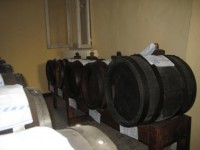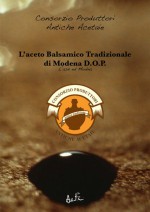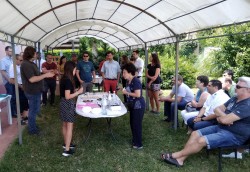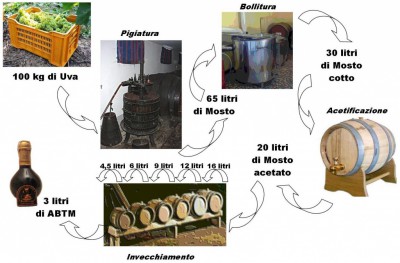How is produced Traditional Balsamic Vinegar
Natural products and meticulous work of aging
 The main difference between vinegar and balsamic vinegar lies in the raw material: it is wine for the vinegar, while it is grape must for the balsamic vinegar.
The main difference between vinegar and balsamic vinegar lies in the raw material: it is wine for the vinegar, while it is grape must for the balsamic vinegar.
On the basis of the experts’ opinion, three elements are fundamental to produce balsamic vinegar: the quality of the grapes, the composition of the vine land and the extremely slow preparation and transformation process of the grape must.
Among the grape types traditionally destined to the production of balsamic vinegar, Trebbiano grapes and some Grasparossa or Ancellotta Lambruscos are considered the most qualified because they are characterized by a constant acid-sugar relation and thickness.
The preparation of the balsamic vinegar free of whatever additional aromatic substances starts with the grape pressings into vinification vats; in less then 24 hours the grape must is sieved and is left boiling on a low flame until its volume is reduced to its half (click for more info).
Then it is left cooling down and poured into small barrels made of superior wood, not treated with any chemical substances. The barrels, however, must be filled with grape must for only 70% of their volume.
 After one year the must has to be poured into smaller barrels and the same has to be done over and over in the following years. The special barrels are made of various different woods and have a scalar capacity. On an average it is possible to get about Kg. 100 of cooked must out of Kg. 200 of fresh grapes, but at the final stage of the pouring off process only a few litres of balsamic vinegar are left.
After one year the must has to be poured into smaller barrels and the same has to be done over and over in the following years. The special barrels are made of various different woods and have a scalar capacity. On an average it is possible to get about Kg. 100 of cooked must out of Kg. 200 of fresh grapes, but at the final stage of the pouring off process only a few litres of balsamic vinegar are left.
The barrels used for the slow acetification process (which derives from the natural fermentation and the progressive product concentration) are traditionally stored in the house attics where the cold is very intense in winter and the summer heath is strong.
 To better understand the production of traditional balsamic vinegar Modena it is recommended the following book: "The Traditional Balsamic Vinegar of Modena". It is edited by Andrea Ferrari Group and it is an informative book of 96 color pages full of pictures. It describe more than 60 recipes from appetizer to dessert available in Italian and in English . The ;Interested guests could buy the book directly through our web-form the price is 30 € including the shipping (only E.U.) or in this web book-shop. Depth technical details are not easy to find because the oral tradition and the "secrets", preserved by each producer, did not encourage the publication of written documentation on the production techniques. However a good choice could be: "Caratterizzazione tecnica e scientifica dell'Aceto Balsamico Tradizionale di Modena" unfortunately not easily available on the market but accessible in many libraries in the region.
To better understand the production of traditional balsamic vinegar Modena it is recommended the following book: "The Traditional Balsamic Vinegar of Modena". It is edited by Andrea Ferrari Group and it is an informative book of 96 color pages full of pictures. It describe more than 60 recipes from appetizer to dessert available in Italian and in English . The ;Interested guests could buy the book directly through our web-form the price is 30 € including the shipping (only E.U.) or in this web book-shop. Depth technical details are not easy to find because the oral tradition and the "secrets", preserved by each producer, did not encourage the publication of written documentation on the production techniques. However a good choice could be: "Caratterizzazione tecnica e scientifica dell'Aceto Balsamico Tradizionale di Modena" unfortunately not easily available on the market but accessible in many libraries in the region. An nice book for a deep study is the second edition of "Il Balsamico della Tradizione Secolare.". Consorteria of 'Traditional Balsamic Vinegar of Spilamberto, after the success of the first volume came out in 1999, offers a new edition, revised and updated. The book is aimed not only to amateurs and producers, but also to the merely curious who'll learn the history and timeless methods of this unique product. Actually available only in Italian.
An nice book for a deep study is the second edition of "Il Balsamico della Tradizione Secolare.". Consorteria of 'Traditional Balsamic Vinegar of Spilamberto, after the success of the first volume came out in 1999, offers a new edition, revised and updated. The book is aimed not only to amateurs and producers, but also to the merely curious who'll learn the history and timeless methods of this unique product. Actually available only in Italian.
